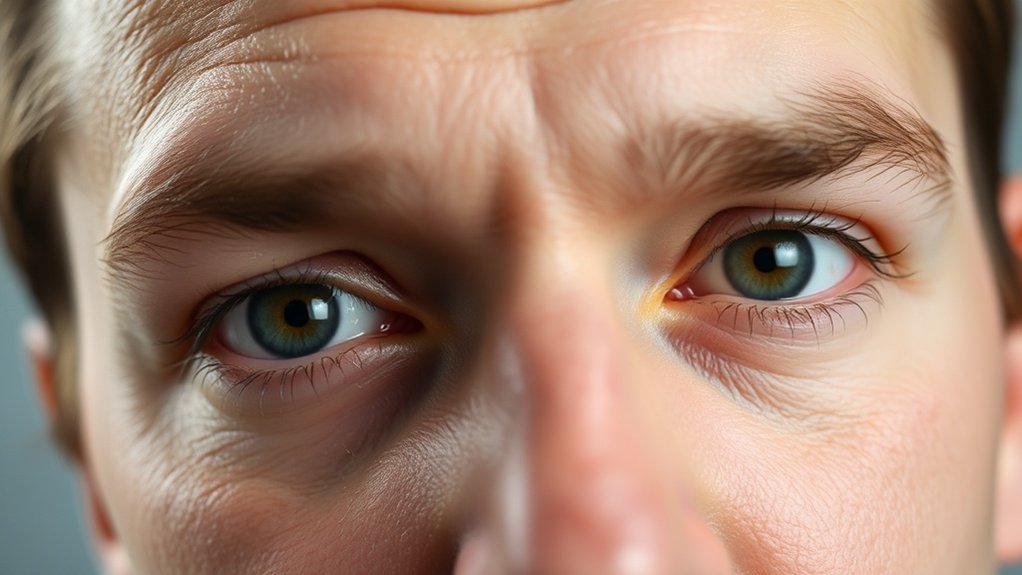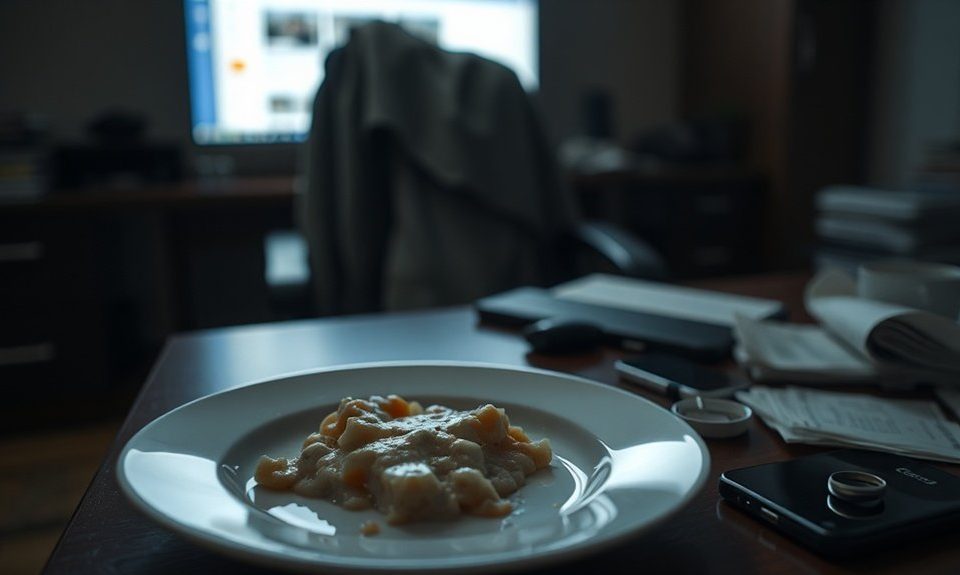Deceptive individuals display six primary eye-contact indicators during confrontation. Excessive blinking and rapid eye movements signal cognitive stress from truth suppression. Gaze avoidance occurs when discussing specific locations or timeframes. Upward and rightward eye movements indicate fabricated memory construction rather than genuine recall. Increased touching or rubbing around the eyes represents stress-induced self-soothing behavior. Darting glances toward exits reveal internal anxiety and escape planning. Prolonged staring attempts to overcompensate for nervous behavior. Understanding these physiological markers provides deeper investigative insights.
Key Takeaways
- Excessive blinking and rapid eye movements often indicate cognitive stress from suppressing truth and constructing lies during questioning.
- Avoiding direct eye contact during specific questions about locations and timeframes reveals cognitive burden and fear of detection.
- Upward and rightward gaze direction signals fabricated memory construction rather than genuine memory recall, especially about suspicious activities.
- Increased eye rubbing or touching around the eyes serves as stress-response self-soothing behavior during deceptive communication attempts.
- Darting glances toward exits combined with overcompensated staring reflects internal anxiety masked by projected confidence during dishonest interactions.
Excessive Blinking and Rapid Eye Movements During Questioning
When individuals experience cognitive stress during interrogation, their autonomic nervous system often triggers involuntary ocular responses that manifest as increased blink rates and erratic eye movements. Research indicates that deceptive individuals typically exhibit excessive blinking patterns, often doubling their baseline frequency when fabricating responses. These physiological markers emerge as the brain simultaneously processes truth suppression and lie construction, creating measurable neurological strain.
Rapid eye movements frequently accompany these elevated blink rates, particularly during direct questioning about suspected infidelity. The eyes may dart laterally or display micro-saccades as internal conflict intensifies. Partners observing these behaviors should note timing correlation with specific questions. However, baseline establishment remains essential, as individual variations exist. Environmental factors like lighting and fatigue can influence these responses, requiring careful contextual analysis for accurate interpretation. Additionally, understanding common patterns among repeat cheaters can provide valuable insights into their deceptive behaviors and motivations.
Avoiding Direct Eye Contact When Discussing Specific Times or Places
Beyond the involuntary physiological responses of excessive blinking and erratic movements, deliberate gaze avoidance presents another significant behavioral indicator during deception detection. When individuals engage in deceptive storytelling about their whereabouts or activities, they frequently demonstrate strategic eye contact withdrawal during essential moments of questioning. This pattern becomes particularly pronounced when partners inquire about specific locations, timeframes, or circumstances surrounding alleged infidelity.
Research indicates that deceivers instinctively recognize the vulnerability of maintaining direct eye contact while fabricating details about concrete events. The cognitive burden of constructing false narratives while managing emotional regulation triggers fear signals that manifest as purposeful gaze diversion. Partners may observe their significant other suddenly looking away, studying objects, or redirecting attention precisely when discussions focus on verifiable details like restaurant names, meeting locations, or timeline specifics. Additionally, the integration of surveillance techniques can reveal patterns that correlate with these deceptive behaviors during conversations about infidelity.
Looking Up and to the Right While Constructing Answers
Eye movement patterns reveal critical neurological processes during deceptive communication, with upward and rightward gaze direction serving as a reliable indicator of fabricated memory construction. When partners create false narratives about their whereabouts or activities, their eyes typically shift upward and rightward as they access visual construction centers in the brain. This differs markedly from genuine memory recall, which activates different neural pathways and corresponding eye movements. The cognitive dissonance experienced during deliberate deception triggers increased mental effort, manifesting through these distinctive ocular patterns. Research demonstrates that individuals constructing fictional scenarios consistently exhibit this specific gaze direction while formulating responses. Partners may notice prolonged upward-right eye positioning when questioned about suspicious circumstances, particularly when fabricating detailed explanations about timeline discrepancies or unexplained absences. Understanding these eye movement patterns can assist private investigators in determining the credibility of the accused during cheating spouse investigations.
Increased Eye Rubbing or Touching Around the Eyes
Although neurological stress manifests through various physical behaviors, tactile self-soothing around the ocular region represents one of the most pronounced physiological responses to deceptive cognitive load. When individuals fabricate information, eye anxiety triggers involuntary touching behaviors that serve as emotional regulation mechanisms. These subconscious gestures emerge from heightened sympathetic nervous system activation during dishonest communication.
Research indicates that deceptive individuals exhibit notably increased periocular touching compared to truthful responses. The behavior stems from psychological discomfort creating physical tension around sensitive facial areas.
- Rapid blinking followed by immediate eye rubbing
- Pressing fingertips against closed eyelids during questioning
- Scratching or massaging the temple regions near the eyes
- Covering one or both eyes with palms momentarily
These tactile responses represent automatic stress-relief attempts when cognitive resources become overwhelmed by maintaining false narratives. Furthermore, community drug awareness initiatives can serve as a preventive measure against the detrimental effects of substance abuse on mental health, creating an environment that discourages dishonesty and deception among youth.
Darting Glances Toward Exits or Distractions Mid-Conversation
How does cognitive dissonance during deception manifest through unconscious gaze redirection patterns? When individuals fabricate explanations about their whereabouts or activities, their eyes frequently dart toward exits, phones, or environmental distractions mid-conversation. This involuntary behavior occurs because the deceiver’s mind seeks escape routes from the psychological pressure of maintaining false narratives.
Research indicates that distraction indicators emerge when cognitive load overwhelms the brain’s ability to maintain steady eye contact while constructing lies. The unfaithful partner’s gaze may repeatedly shift toward doors, windows, or digital devices as their subconscious processes seek relief from confrontation anxiety. This behavior can often suggest the violation of trust, a core element in many infidelity cases.
These evasive behavior patterns intensify during direct questioning about suspicious activities. The eyes instinctively search for diversions that might redirect conversation topics, revealing the internal struggle between maintaining deception and managing emotional discomfort.
Prolonged Staring to Overcompensate for Nervous Behavior
Overcompensation frequently drives deceptive individuals to maintain unnaturally intense eye contact as a counterbalance to their internal anxiety. This forced behavior creates deceptive confidence while masking genuine emotional responses. The excessive staring attempts to project trustworthiness but often achieves the opposite effect.
Research indicates that liars consciously manipulate their gaze patterns when aware that eye contact signals honesty. This emotional masking produces rigid, uncomfortable interactions that feel performative rather than natural.
- Unblinking stares lasting 8-10 seconds without natural breaks
- Forced smile combinations with intense eye contact creating facial tension
- Deliberate head positioning to maintain direct sight lines during sensitive topics
- Micro-expression suppression visible through slight muscle twitches around the eyes
These behaviors create an unsettling dynamic that contradicts authentic intimate communication patterns. Additionally, the insights from private investigators on witness credibility are essential in evaluating these deceptive behaviors during interrogations.
Frequently Asked Questions
Can Cultural Differences Affect How Eye Contact Patterns Indicate Deception?
Cultural differences greatly impact eye behavior interpretations regarding deception detection. Research demonstrates that cultural norms dictate acceptable eye contact patterns, with some cultures viewing direct gaze as respectful while others consider it confrontational. What appears deceptive in one cultural context may represent normal communication patterns in another. Partners from different backgrounds must understand these variations, as misinterpreting culturally-influenced eye behavior can damage trust and create false suspicions of dishonesty.
How Accurate Are These Eye Contact Clues Compared to Other Lie Detection Methods?
Eye contact patterns demonstrate moderate accuracy rates of 60-70% in detecting deception, comparable to other behavioral indicators but less reliable than physiological measures. Neural response monitoring and micro-expression analysis often yield superior results. However, eye contact clues excel when combined with additional emotional cues, creating a thorough detection framework. Individual variations and cultural factors greatly influence baseline accuracy, requiring careful calibration for ideal effectiveness.
Do Left-Handed People Show Different Eye Movement Patterns When Lying?
Research suggests left-handed individuals may exhibit reversed eye movement patterns compared to right-handed people when accessing different cognitive processes. However, studies on left handed behaviors during deception show mixed results. While some researchers propose that left-handed people’s eye movement directions might be opposite when lying, the scientific evidence remains inconclusive. Individual variations in neurological organization make reliable lie detection through eye movements particularly challenging for left-handed subjects.
Can Someone Train Themselves to Control These Involuntary Eye Behaviors?
Individuals can develop some control over eye behaviors through dedicated self regulation techniques and systematic eye behavior training. Research indicates that while baseline involuntary responses remain largely intact, conscious practice can help people maintain more consistent gaze patterns and reduce obvious tells. However, micro-expressions and subtle pupil responses typically remain beyond voluntary control, making complete mastery of deceptive eye movements extremely difficult for most people to achieve reliably.
Are These Signs Reliable for Detecting Lies About Non-Relationship Topics?
These eye-based indicators show limited reliability for general lie detection beyond relationship contexts. Research demonstrates that non verbal cues, including eye movements, vary markedly across different deception scenarios and individual personalities. While some patterns may persist across topics, factors like cognitive load, emotional stakes, and cultural background influence their manifestation. Trained observers achieve only marginally better accuracy than chance when relying solely on these behavioral markers for detecting lies.
Conclusion
These eye movement patterns are real physiological responses that happen when someone’s brain is working overtime to create lies. While everyone’s different, studies show these eye behaviors pop up when the mental effort of making up false stories kicks in. But don’t rely on just one sign – you need to look at the whole picture since culture, medical conditions, and personality all affect how people normally make eye contact. Real investigation means looking at way more than just where someone’s eyes go.
Let us Help
Stillinger Investigations, Inc.
170 Meeting St, Charleston, SC 29401
843-212-1338







